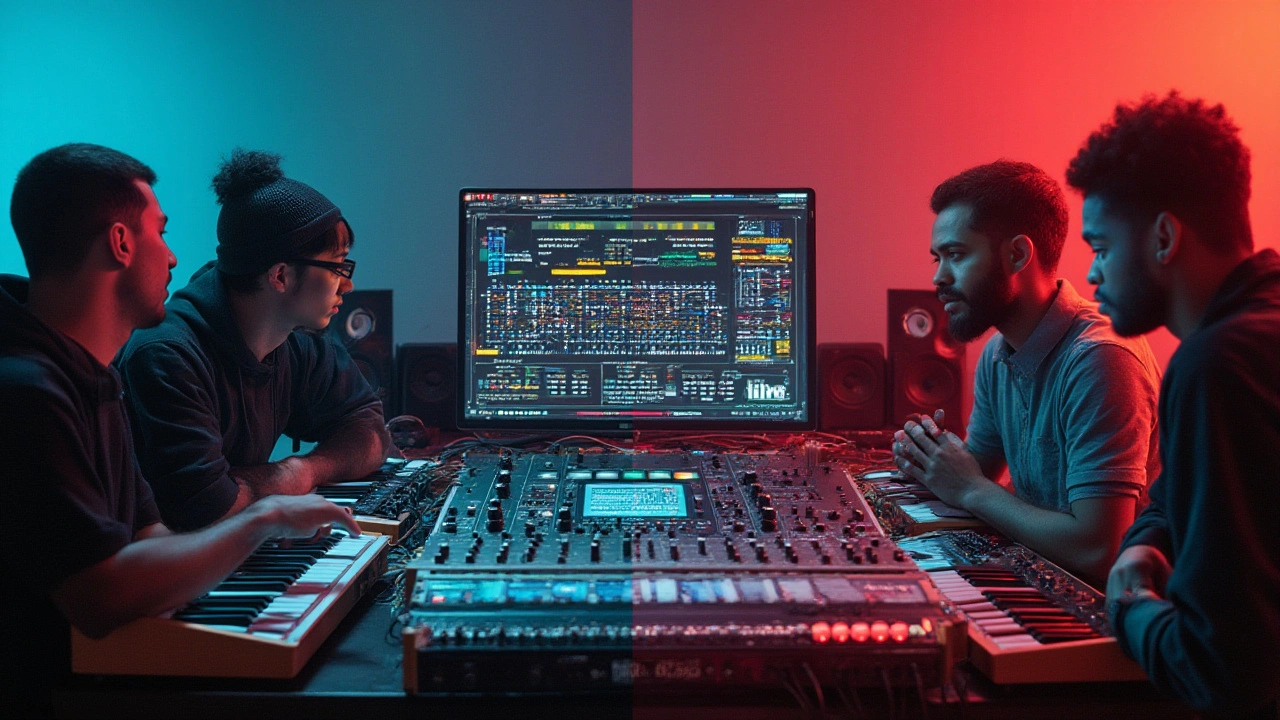Picture this: a single button gets pressed, and a wave of sound fills the air that could as easily make your grandma dance at a wedding as it could rile up tens of thousands at a music festival. Hard to believe that behind this magic are not only instruments but also lines of code, plastic knobs, and a wild mix of curiosity and obsession. Electronic music has shaken the world, blurring lines between science and art, giving us beats and atmospheres that feel like the future in your headphones. Most people enjoy a massive drop or a hypnotic ambient loop, but what exactly goes into crafting this world of sound?
The Sound Palette: From Analogue to Digital Wizardry
It’s staggering to realize just how many gadgets can fit into one producer’s backpack. At the heart of electronic music lies the urge to create new sounds from scratch. Old-school legends swear by the magic of analog synthesizers from the 1970s and 80s. These chunky beasts, like the Minimoog Model D or Roland’s classic Jupiter-8, don’t just spit out sound—they sculpt tone in living, shifting ways. Tubes heat up, circuits respond just that tiny bit differently every time, and if you talk to diehard fans, they’ll swear you can ‘feel’ analog. Vintage synths fetch eye-watering prices, with a 1980s Roland TB-303 bass synth, once considered a commercial flop, now costing more than a decent secondhand car in Melbourne.
But let’s not get lost in nostalgia. Digital synths and music production software, called DAWs (Digital Audio Workstations), have exploded the possibilities. Ableton Live, Logic Pro, and FL Studio are names that pop up in forums more often than the weather forecast. With these, producers control sound in ways impossible with old hardware—think micro-editing, unlimited layering, or building instruments that defy physics. And it’s not just solo efforts; crazy-collaborative platforms mean one person in Melbourne can be working ‘live’ with another in Berlin as if they’re side by side. No wonder you rarely hear the same track twice.
Every sound starts as a waveform, shaped through oscillators, filters, and modulators. You might be surprised how the notorious ‘Reese bass’—a gritty, swirling tone in countless drum’n’bass anthems—was discovered by mistake on a humble Roland Juno. Producers often chain effects like delay, reverb, and distortion, stacking them like Lego pieces for textures no one’s ever heard. Sampling is another big game: snipping everything from the dulcet tones of an old radio host to field recordings—there’s a camp in France where producers record electric sheep fences and crunch the samples into beats. I know more than one local artist who’s sampled the Melbourne trams' door chimes. In electronic music, everything is fair game.
| Instrument | Type | Year Released |
|---|---|---|
| Minimoog Model D | Analog Synthesizer | 1970 |
| Roland TB-303 | Bass Synthesizer | 1981 |
| Yamaha DX7 | Digital Synthesizer | 1983 |
| Akai MPC60 | Sampler/Sequencer | 1988 |
| Ableton Live | DAW | 2001 |
Sound design is not stuck in a lab; it spills out onto stages and into headphones worldwide. Boutique instrument makers churn out synths the size of a lunch box, powerful enough for live sets or busking in Federation Square. Modular synthesizers form custom-built musical “Frankensteins,” each truly one of a kind. Don’t ignore the role of software—synths like Serum or Massive X let anyone with a laptop summon up sounds from gentle rain to digital mayhem, as long as you can handle a few hundred virtual knobs.

Beats, Structure, and the Human Touch
At first glance, it’s easy to think electronic music is just button-pressing and knob-turning. Spend time with a seasoned producer, though, and you’ll realise it’s a lot more personal. The grid in your DAW might look robotic, but every drum hit and every swell in the synth is a fingerprint. Producers experiment endlessly with tempo (BPM, or beats per minute) and rhythm. If classic techno keeps a strict 4/4 beat at 130 BPM, trap might drop all the way down to 70 BPM, drawing influence from the footwork and hip hop scenes. House music, with a ‘four on the floor’ kick drum, sets the mood for dance parties from Berlin’s Berghain to backyard barbies in Brunswick.
People often overlook how experimental mainstream artists can get. Flume, who hails from Sydney, pushed the use of unconventional samples and odd-timed drums straight into pop territory, winning a Grammy and setting trends—his chopped-vocal style is now everywhere. Aphex Twin, meanwhile, can still fry your brain by dropping beats that sometimes change meter five times in the same track. No surprise, then, that emerging producers tinker with ideas like polyrhythms or syncopation, layering hop-skip rhythms over straight beats to make people move in new ways.
Human performance still plays a big role in crafting electronic music. Many pros record live takes, nudging notes off the grid for a groove that feels alive. Here’s a handy tip: Instead of hitting quantize (which snaps everything to perfect timing), try shifting individual notes manually, or even recording some claps or shakers with your phone’s mic—these little wobbles and imperfections make a world of difference. Daft Punk was famous for blending robot precision with soulful licks played on real instruments and then mangled with effects, blurring the human-machine divide so well you can’t always tell what’s what.
| Genre | BPM Range |
|---|---|
| Techno | 120–140 |
| House | 115–130 |
| Dubstep | 138–150 |
| Drum and Bass | 160–180 |
| Trance | 125–150 |
Arrangement is a battleground. Keeping listeners interested is a real craft, especially when repetition could bore them stiff. Producers borrow tricks from pop—think dramatic breakdowns, hands-in-the-air build-ups, and satisfying payoffs at the drop. Others lean toward ambient music, using texture and evolving chords for a feeling more like floating than dancing. The best producers plan their tracks like a roller coaster: slow climbs, unexpected turns, sometimes even plunging into total silence before bringing the beat back with a thump.
Surprisingly, melody and harmony are just as important in electronic music as they are for a piano ballad or rock anthem. Getting a hook to stick is a dark art. You’ll see folks on Reddit dissecting why certain Daft Punk riffs burn themselves into your brain after one listen. Try playing around in odd scales or layering simple melodies over lush chords—in electronic music, breaking a few rules can lead to sounds that feel totally fresh.

Behind the Scenes: Tips, Tricks, and Creative Lifelines
Anyone itching to make electronic music today faces a wild buffet of options, each with its own quirks and unexpected snags. Your first battle is often choice overload: Too many plugins, too many YouTube tutorials, and an avalanche of free sound packs. Rather than drown, most veteran producers recommend picking one DAW and sticking with it for a while. Master your tools, don’t just collect them. Ableton Live, for example, shines for both live performance and studio work; FL Studio boasts a huge user community full of creative ideas. As your skills grow, you’ll have a better eye for which new equipment solves a real problem instead of just adding confusion.
Don’t fall for the myth that only expensive gear makes great music. Huge numbers of charting producers started with headphones and a cheap laptop. Billie Eilish’s groundbreaking debut album was made in a tiny bedroom with basic gear and a heap of creativity. The real trick is to experiment and finish tracks, not wait for the ‘perfect’ setup. Focus on nailing fundamental skills: sound selection, EQ, compression, and arrangement. Polish these, and you’ll be ahead of most beginners before you even think about spending big money.
Sound design often jumps ahead through happy accidents. Record random household sounds and tweak them beyond recognition. Layer different instruments you wouldn’t expect—like clashing a detuned vocal sample with a glitched-out guitar riff. Save everything, including your half-finished ideas; they often get repurposed months later. Trust your ears more than your eyes. Yes, waveforms look cool, but what matters is how your track feels. If something sounds good but looks “wrong” on your meters or spectrum analyzer—even seasoned professionals say, use your gut.
Collaboration is a lifeline for breaking creative blocks. Melbourne’s scene, for example, is buzzing with collectives where producers swap stems (pieces of tracks), remix each other’s beats, and meet up for “hardware jams” at local record stores. Don’t be shy about reaching out online—Reddit’s r/edmproduction and Discord servers can hook you into global minds as quick as a DM.
Mixing and mastering add the final polish, making sure your music sounds thumping in a club or intimate on headphones. Here’s a tip that never gets old: Check your mix in as many places as possible—laptop speakers, car audio, or even the crummy speaker in your phone. What pumps in your studio might fall flat somewhere else. Melbourne’s clubs often have massive sound systems tuned differently in every corner. Producer Charlotte de Witte, who headlines global techno festivals, is famous for fine-tuning tracks in real venues before release—proof that context is everything.
If you’re diving into live gigs, prepare to improvise. Crowds love moments that feel special and unscripted, even in genres that start with strict patterns. Use controllers, effects, or even live vocals to keep things wild. Bring backup files—technology can (and will) throw surprises at you. Veteran DJs joke that no gig is complete without at least one mini meltdown, but rolling with it is part of the fun.
Want to stand out? Develop your own sound signature. Whether it’s an odd percussion sample, bizarre vocal chop, or a synth patch no one else uses, uniqueness is key in a digital world where thousands upload beats every hour. Don’t chase the latest trend—learn from classic tracks, sure, but then twist old ideas in your own weird way. Niche genres like vaporwave or lo-fi hip hop started as jokes or experiments, and now shape global tastes, popping up everywhere from gaming soundtracks to high-fashion catwalks.
The thrill of creating electronic music is the wild balance of control and chaos. You can copy the legends, hack together new genres, or smash every rule you can find. One undeniable thing? The *art of crafting sounds* puts power and play in your hands, whether you’re playing to a packed festival or mixing alone at 3am in your bedroom. Dive in, get messy, and remember: if it excites you, chances are you’re not alone.

